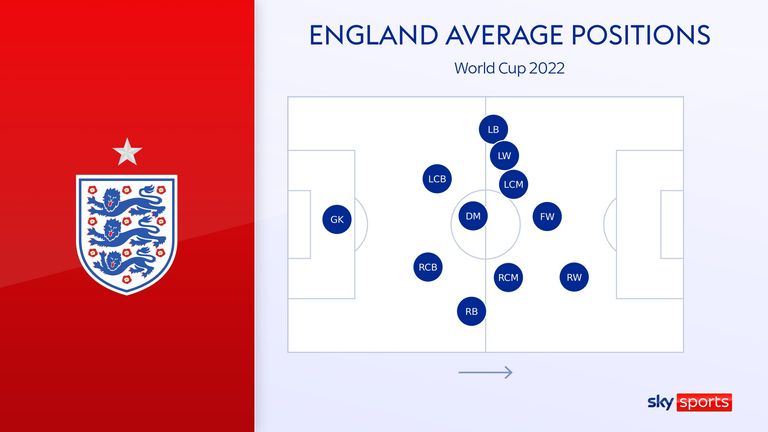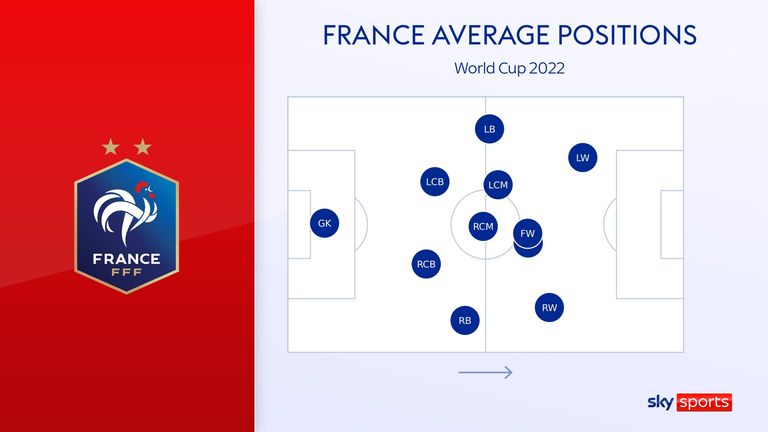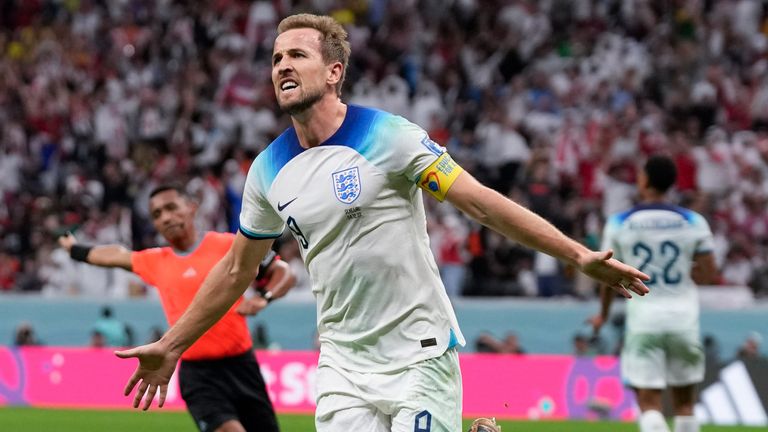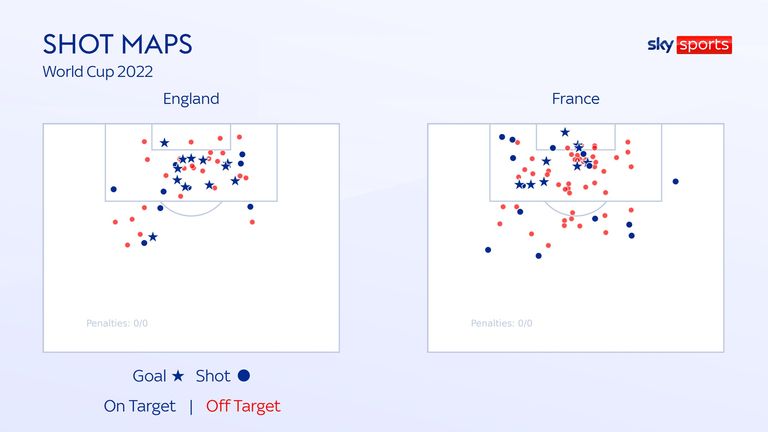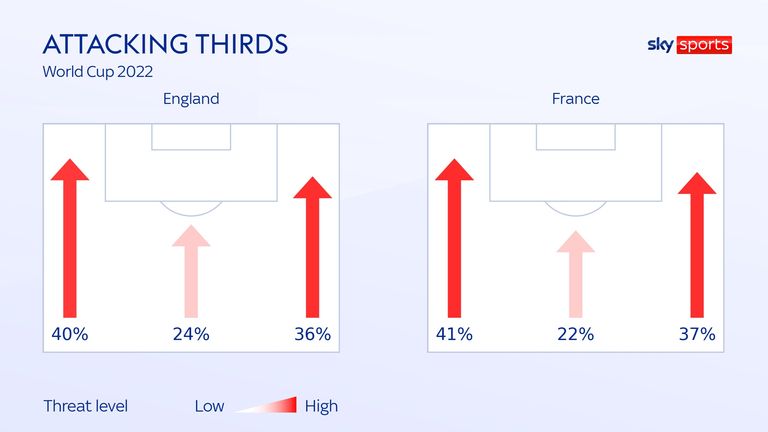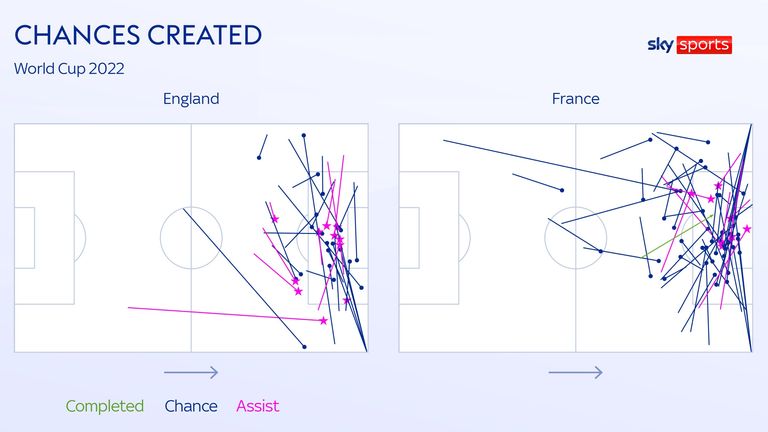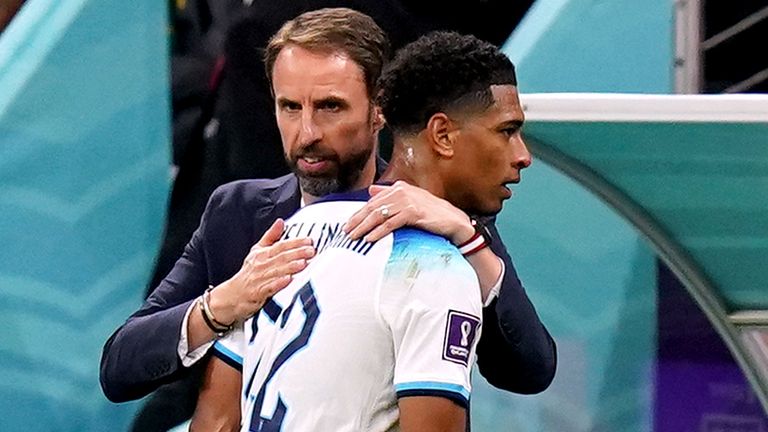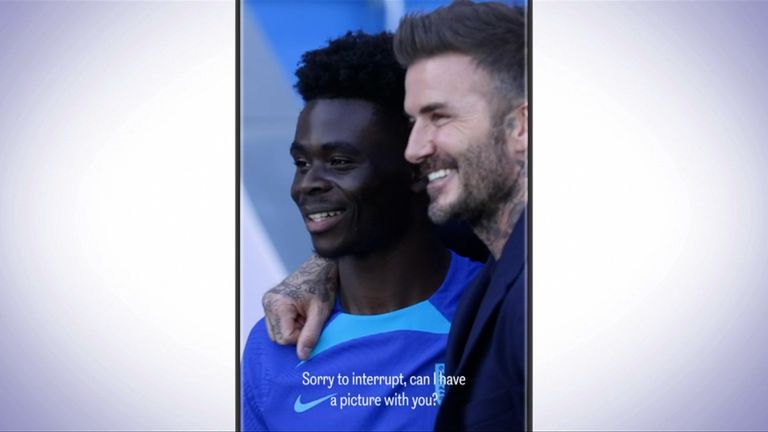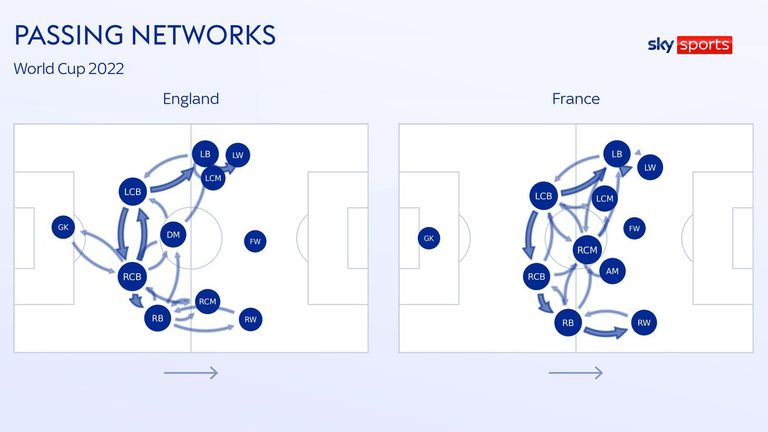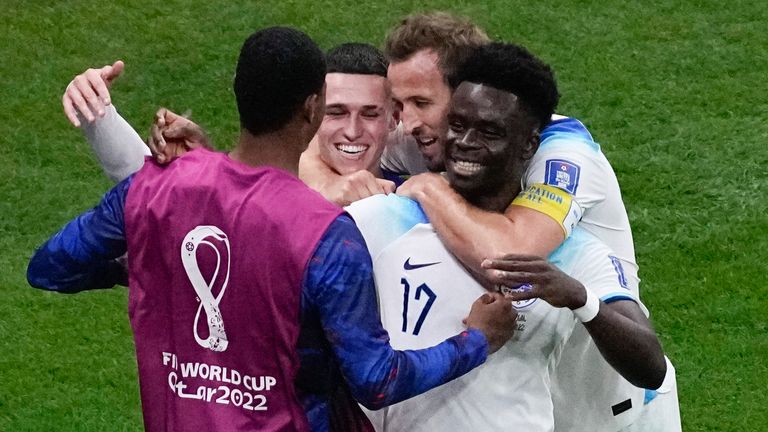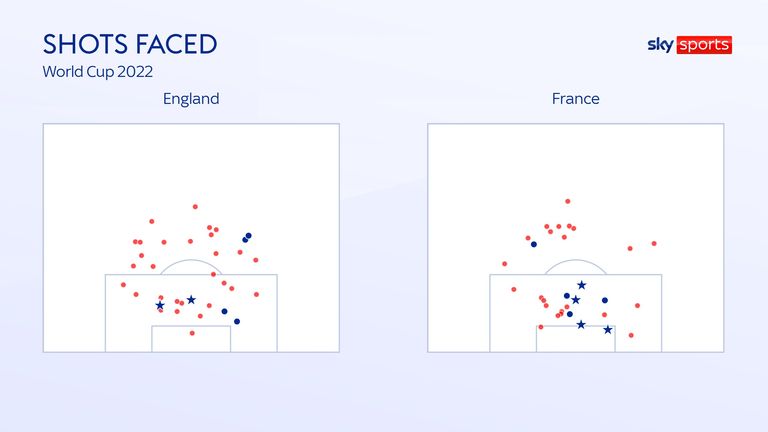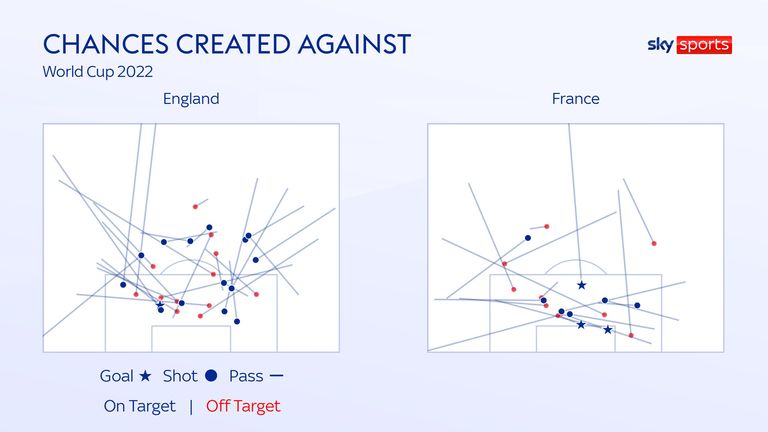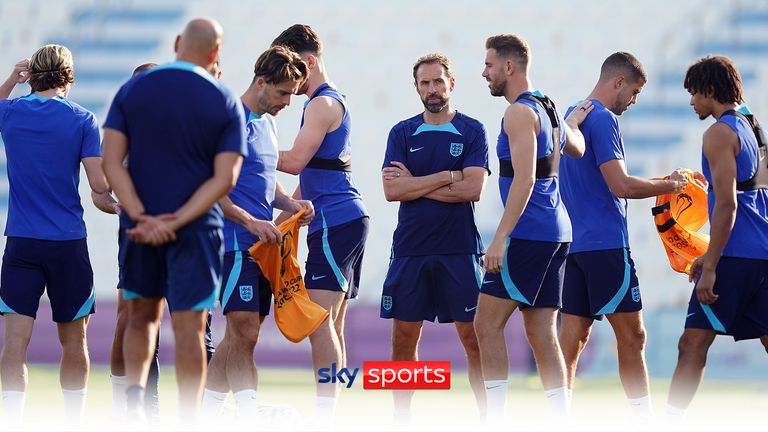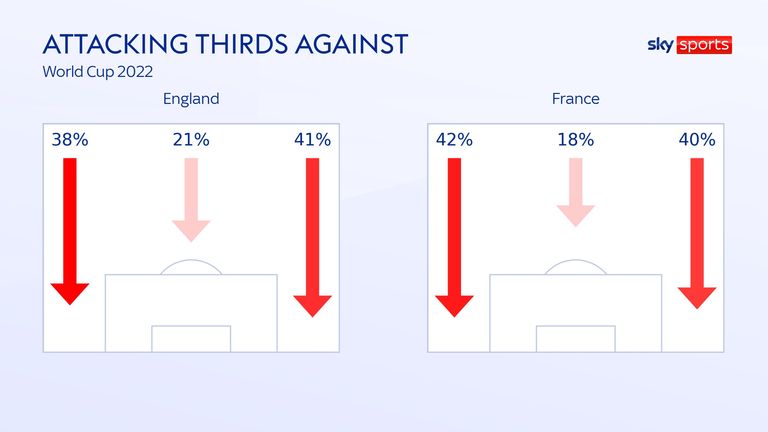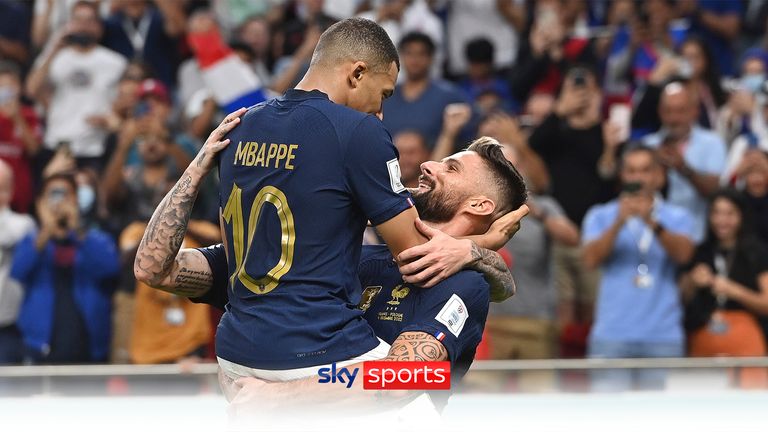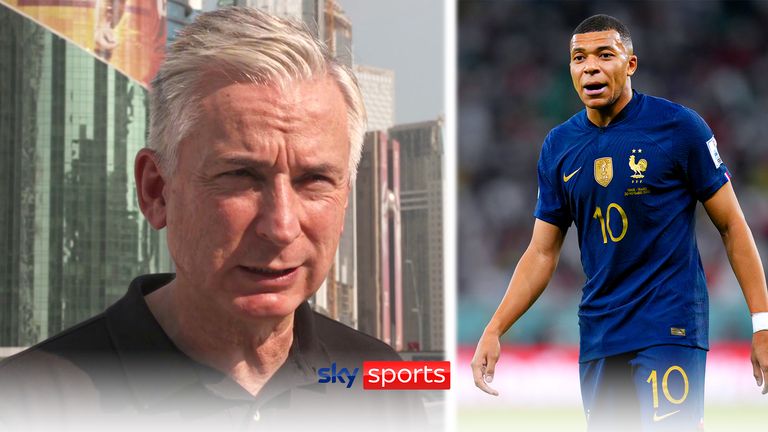England face France in the World Cup quarter-finals on Saturday – but how do the teams’ tactics, styles, players and form compare ahead of the blockbuster clash?
World-stage pedigree and stakes
The winner of England vs France will progress to a semi-final match-up against Portugal or Morocco with the victor of those four teams going on to face either Brazil, Argentina, Netherlands or Croatia in the World Cup final at the Lusail Stadium on December 18.
France are the reigning world champions and, in modern history, reached the quarter-finals stage in 2014, lost to Italy in the 2006 final and beat Brazil to win the 1998 tournament on home soil.
England endured regression in successive World Cups after reaching the last eight at the 2006 tournament in Germany. After losing to Germany in the last 16 four years later, they suffered a humiliating group-stage exit at Brazil in 2014 under the stewardship of Roy Hodgson – who stepped aside when his contract expired following upset to Iceland in the round of 16 at Euro 2016.
Sam Allardyce took the reins but left the role after merely one game in charge following a newspaper sting – with Gareth Southgate taking the helm on a caretaker basis but assuming the role on a permanent basis four games later.
The former England defender steered them to their first semi-final stage at the World Cup in 28 years but lost 2-1 to Croatia, before guiding his side to the Euro 2020 final – played in 2021 due to the Covid-19 crisis – and losing the penalty shootout 3-2 against Italy.
Which team is in better form?
England qualified for the knockout stages with seven points after beating Wales 3-0 in their final group game, having drawn 0-0 with the USA and beating Iran 6-2 in their opener.
The Three Lions cruised past Senegal in the round of 16 with a second-successive 3-0 victory after enduring a tricky opening 30 minutes. In total, Southgate’s side have scored 12 goals and conceded only twice.
France guaranteed their spot in the round of 16 after just two group games following a 4-1 win over Australia and a 2-1 win against Denmark. Therefore, Didier Deschamps made nine changes to his starting XI for the final group game but suffered a shock 1-0 defeat to Tunisia.
The world champions comfortably beat Poland 3-1, thanks to Olivier Giroud and two goals from Kylian Mbappe. In total, France have scored nine goals and shipped four across their four games.
Historic rivalry
On paper, England’s record against France is impressive with 17 wins, nine defeats and only five draws. Additionally, France have never beaten their neighbours at a World Cup.
However, that record is largely due to historical success, with the French frequently reigning supreme in recent head-to-heads since 1992 – a 2-1 win at Euro 2004 and four friendlies. England’s most recent success was a 2-0 friendly win seven years ago.
What’s the style?
Southgate has surprised many by deploying – and sticking – with a 4-3-3 formation in their four games at the tournament and is yet to revert to his favoured three-at-the-back system – but that might change against the French.
To date, England have utilised their array of attacking talents with devastating effect, with all recognised forwards getting on the scoresheet – bar Callum Wilson.
Left-back Luke Shaw has typically pushed higher than his counterpart down the right channel, supporting a cluster of close activity with the left winger and Jude Bellingham, while Jordan Henderson has patrolled the right-of-centre region effectively.
France have typically set up in a 4-2-3-1 system, with Adrien Rabiot and Aurelien Tchouameni holding in midfield.
Olivier Giroud frequently drops deeper, with his average touches in line with Antoine Griezmann – who is also notably deeper than his regular role.
The wingers push high and wide, with Mbappe farthest forward – ahead of counterpart Ousmane Dembele.
Attacks analysed
Goal sources
England have scored a tournament-topping 12 goals – level with Portugal – while France rank third out of the remaining sides with nine to date.
Southgate’s side have been ruthless in front of goal, scoring their haul from just 21 shots on target and doubling their expected-goals ratio – while no other side has scored more from open play.
France have netted nearly half of their goals from crosses and scored a tournament-high three headed goals, boosted by Giroud’s aerial prowess, but England also pose considerable threat from wide passes – so expect activity down the channels.
Both sides are at polar ends of the spectrum for goal sources: eight England players have got on the scoresheet to date, compared with just three for France – underlying the breadth of talent at Southgate’s disposal in attacking areas.
England tend to fire from central areas inside the opposition box, with a higher frequency also struck from right-of-centre areas than the left – while shots from range have typically been fired from left-of-centre areas.
France have far more success in left-of-centre areas inside the box, for goals and accuracy – an area occupied by in-form Mbappe. However, Giroud has also been clinical centrally, in and around the six-yard box.
Deschamps’ side are also twice as likely to fire from distance – but are yet to score from outside the opposition box from their 19 attempts.
In terms of the players, Mbappe leads the way in the race for the Golden Boot on five goals. Giroud sits two shy on three, level with England duo Buyako Saka and Marcus Rashford – with the latter netting his tally from merely 132 minutes on the field.
Rashford and Mbappe have doubled their expected-goals figure but that ratio pales considerably compared with Saka, whose three goals come from an xG value of just 0.58.
Creative sparks
Both teams have attacked more down their respective left flanks – four-per-cent more than the right channel, to be precise.
Mbppe drives the swing for the French, but England tend to rotate players and positions in that area – which might be influenced by Shaw’s more advanced style, when paired with Kyle Walker.
The graphic below shows every pass leading to a shot on goal for both teams and emphasises the danger France pose from crosses – but also passes from outside the box down the left channel.
England have primarily created chances from shorter exchanges, from passes just outside the box into runners inside the opposition’s penalty area.
Harry Kane has notched three assists from only five chances created at this World Cup – surpassing his expected-assist tally fivefold. Phil Foden has also come to the fore and created goals with two of his four chances created.
In addition to his goal threat, Mbappe also poses a creative threat for England, teeing up team-mates for shots on eight occasions and registering two assists – level with Dembele and Theo Hernandez.
However, Southgate will not overlook Griezmann, who, despite playing deeper and only having one assist so far, has created 15 chances and recorded 2.67 expected assists – more than any other player from either team.
Speedsters collide
One of the most prominent debates building up to the quarter-final has been how England will cope with Mbappe’s speed.
Firstly, how do the teams fare, generally? Well, England have clocked 149 more sprints and 330 more high-speed runs than their rivals in Qatar.
However, the debate centres around each side’s primary speedster: Walker and Mbappe, respectively. In terms of top speed registered by both players, the France winger has clocked 35.3km/h – one km/h faster than Walker.
In fact, seven France players have surpassed Walker’s fastest burst to date – but many would argue Walker has yet to be fully tested or needed to apply the afterburners in Qatar.
Declan Rice tops the rankings for high-speed runs ahead of Tchouameni and team-mates Stones and Bellingham, while the latter has registered 249 sprints – which is 50 more than any other player.
The hard yards
England have clocked 451km across their four games, which is 12.4km more than France.
Rice has covered the most ground, running more than a marathon distance at 44.3km, ahead of Tchouameni, Bellingham, Rabiot, Shaw and Stones – with the latter pair also ranking top for most distance covered at walking speed among outfield players.
Progress on the ball
Critics have regularly accused Southgate of being too defensive during his tenure as England manager – but the stats below reveal England are playing higher up the pitch than any other team at the tournament.
Starting distance calculates the average starting point where passing sequences begin, measured in metres from a team’s own goal-line. Based on this, England’s defensive line typically sits 47.3m up the pitch, which is 3m higher than any other side.
Teams with high lines typically also require intense pressing and counter-pressing styles, to avoid turnovers exposing space behind the advanced defensive line and being vulnerable to the counterattack. France are exceptionally effective at fast breaks with the likes of Mbappe, For this reason, it is likely England will sit deeper than usual on Saturday.
England centre-backs Stones and Harry Maguire lead the way for distance covered with the ball at their feet, with the former running 1,288m and the latter clocking 996m – while both also top the chart for progression upfield.
More notable are the attacking threats posed by France, with Mbappe and Dembele ranking high on the list for carry distance and progress, with Tchouameni also penetrating from midfield.
Young guns and wise heads
England now rank as the youngest team at the World Cup with an average starting age of under 27, but France also rank as the third-youngest.
At just 19-years-old, Bellingham is the only teenager to have clocked minutes, while Real Madrid midfielder Camavinga only turned 20 last month. Saka, William Saliba (both 21), Foden and Tchouameni (both 22) are the remaining under-22s.
At the other end of the scale, France reserve goalkeeper Steve Mandanda earned a start in the 1-0 defeat against Tunisia and is the eldest player among the sides at 38, followed by Giroud and Hugo Lloris (both 36).
Passing analysed
Who will enjoy the lion’s share of possession? The stats suggest England might dominate, narrowly – having enjoyed 64.9 per cent of the ball so far – behind only Argentina.
However, France have registered a higher frequency of successful passes in the final third and England will also need to remain alert to frequent through-balls behind defensive lines.
You can use the interactive table below to explore the similarities and differences between the sides in finer detail, but the standout points remain how France are dangerous from crosses and countering at speed, while England are happy to fire long passes and have typically built from deeper areas.
Those numbers translate into the graphic below, which reveals common passing combinations between players for both teams.
Rice has held the fort in England’s central midfield, while Shaw has been a key distribution hub down the effective left flank – with both centre-backs typically feeding the full-backs to push upfield. The ‘to me, to you’, short exchanges between Maguire and Stones is also clearly visualised.
England will be looking to nullify Tchouameni – who stands out as the key distribution engine in the French midfield.
The graphic below highlights how France have been busier in the final third, clocking around 100 more passes just inside the opposition half down both flanks and achieving far more exchanges inside the penalty area.
To elaborate on the above, the table below underlines Tchouameni’s importance to France – clocking 294 successful passes to date, while Shaw, Rice and Bellingham remain key components to England’s passing network.
Southgate will also be looking to block flighted balls into his penalty area and will look to nullify Griezmann, who has attempted a chart-topping 36 passes into the opposition box – which is 11 more than Mbappe.
Who presses hardest?
A key battleground on Saturday will be the press, but England have out-pressed their upcoming opponents in Qatar so far – winning more high turnovers, applying more pressed sequences and making more defensive actions.
The chart below reveals how many passes a team allows their opponent to make before making a ‘defensive action’ – so a lower number represents a more rigorous press.
Here, England reign supreme again – almost matching the Netherlands by allowing opponents only 10 passes before intervening.
Conversely, France average at more than 16 – only Morocco have sat back and allowed opponents to play more.
Soft spots?
While many England fans revelled in the 6-2 win over Iran, Southgate aired his discontent at conceding two goals from set-pieces. However, his side have remained watertight ever since – keeping three successive clean sheets.
In contrast, France are yet to keep a clean sheet and have shipped twice as many goals – leaking one in each of their four games so far.
The disparity disappears for expected goals against with both sides registering around 3.5 conceded, based on the quality of chances against them.
As the graphic below shows, England have restricted opponents to merely four shots on target from inside the box, while France have ceded seven – with two of those scored from the six-yard line.
In terms of creative sources, the maps below plot every pass leading to a shot against the teams and highlights how England are most vulnerable from more ambitious long passes fired from deep down the flanks.
Meanwhile, the majority of chances carved against the French have come from wide areas, closer to the byline.
The graphic below elaborates on these points further, revealing how England have tournament-topping levels of solidity – apart from a band just outside their box – an area where the majority of passes leading to chances against them have come from.
France appear far less solid, with central midfield appearing as an area ripe to exploit, while also having a band of weakness just outside the opposition penalty area.
Previous opponents in Qatar have not found an area of notable weakness down the flanks to date, with around 40 per cent of attacks against the teams coming down both flanks and 20 per cent through the middle.
Who’s red hot?
We don’t really need numbers to establish the in-form player among the teams, but we’ll do it anyway.
Using the Sky Sports Power Rankings, which awards points to players for 35 different match-day statistics, according to starting position, we can reveal the obvious: Mbappe is the most in-form player.
With five goals from his four starts, the 23-year-old has notched 13,262 points, which is 4,572 more than runner-up Rashford – equating to 52 per cent better.
However, let’s not forget Mbappe has played more than twice as many minutes as Rashford, which means the Manchester United forward is in hotter form, per 90 minutes.
A host of England players dominate the higher rungs behind the leading pair, including Saka, Maguire and Bellingham.
Favourites to win?
Stats Perform have been running a live tournament predictor and now position France as favourites to progress to the semi-finals at 55 per cent.
Who starts for England?
So, what would your England starting XI look like to face France? Use our interactive selector to pick your team and formation below, screenshot your selections and share on Twitter @SkyFootball.




